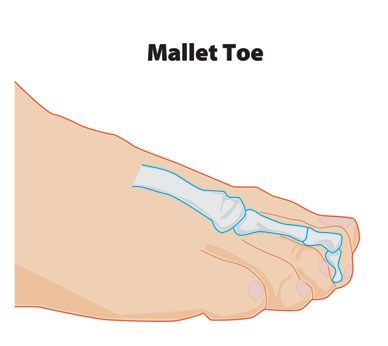About Mallet Toe
Mallet toe is a condition which involves the buckling of the toe at the end of the joint. Typically, a corn develops on the skin which is situated near the tip of the toenail, that is painful and can lead to an ulcer. These painful growths can make the toe swollen and red. Mallet toe is known to be most likely to develop on the second toe, as it is the longest.
Causes
There are two recognised mallet toe types; rigid mallet toe, involving the misalignment of the joints and tightening of the tendons, which usually results in more symptoms; and flexible mallet toe, when the affected toe joints can still be moved.
There are several possible causes of mallet toe. These include; shoes which are too restrictive, particularly ones which have tight toe boxes; trauma to the toe caused by an injury; osteoarthritis; and imbalances in the muscles and tendons of the toes.
There are certain risk factors attached to mallet toe, including; gender, with women much more likely to develop the condition; age, as the risk increases when you get older; diseases such as diabetes and osteoarthritis; and toe length – if your big toe is smaller than your second toe, you might have a higher risk of developing mallet toe.
Symptoms
Typical symptoms of mallet toe include; calluses and corns, usually caused by rubbing against a shoe; swelling and redness on the toe which is affected; and toe ulcers, especially in diabetic patients.
As a result of the symptoms above, mallet toe can cause pain and restricted movement of the toe. Aesthetically, mallet toe is characterised by a joint with an abnormal bend.

Treatment
Mallet toe is diagnosed via a physical examination, and an x-ray is ordered so that your doctor can evaluate the foot joints and bones.
Whether your mallet toe is flexible or rigid can be influential in which treatment is recommended. For toes which are still flexible, changes such as orthotics, including pads and inserts, and wearing roomier footwear can be effective. These pads and inserts offer extra support while relieving pressure on the toe and repositioning it.
Physical exercises to strengthen the toes and increase range of motion can also be advised. These movements can include picking up a towel or marbles using the toes.
Surgery is another option often recommended treating Mallet Toe. Surgical procedures used to address mallet toe are typically focused on releasing the tendon which is causing the bend in the toe joint. Surgery can also involve the removal of bone in order to straighten the toe. This type of surgery, which involves the removal of a bone part, is known as an arthroplasty, or phalangeal head resection. There is also the option of an arthrodesis (joint fusion), which involves the removal of part of the joint, allowing the bones of the toe to grow together.
Joint fusion surgery tends to be the most common method of straightening toes. Often a small wire is inserted down the middle of the toe bones across the joint to hold it still. The wire is removed with no pain in the clinic after 6 weeks. Other methods to fuse joints include screws and other implants.
As with all foot surgery, it is common for swelling to persist for some months after surgery and is completely normal. This swelling will eventually completely subside with time and can take up to 12 months but often goes well before this.










